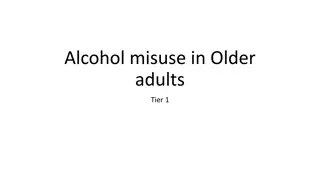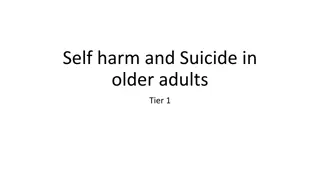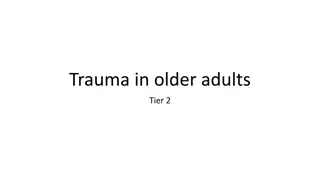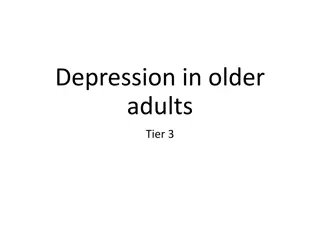Deprescribing in Older Adults: Strategies and Benefits
Deprescribing is a critical aspect of geriatric care to reduce polypharmacy-related issues in older adults. This program, supported by HRSA, emphasizes defining deprescribing, identifying triggers, overcoming barriers, and implementing tools for optimal patient outcomes. Benefits include fewer falls, cognitive improvement, and enhanced quality of life. Understanding the process can lead to better medication management and improved adherence.
Download Presentation

Please find below an Image/Link to download the presentation.
The content on the website is provided AS IS for your information and personal use only. It may not be sold, licensed, or shared on other websites without obtaining consent from the author.If you encounter any issues during the download, it is possible that the publisher has removed the file from their server.
You are allowed to download the files provided on this website for personal or commercial use, subject to the condition that they are used lawfully. All files are the property of their respective owners.
The content on the website is provided AS IS for your information and personal use only. It may not be sold, licensed, or shared on other websites without obtaining consent from the author.
E N D
Presentation Transcript
Geriatrics Case Conference December 5, 2019
Deprescribing in Older Adults Linda Sobeski, PharmD, BCPS Clinical Assistant Professor, UNMC COP December 5, 2019 2
This program is supported by the Health Resources and Services Administration (HRSA) of the U.S. Department of Health and Human Services (HHS) as part of an award totaling 749,926.00 with 0% financed with non- governmental sources. The contents are those of the author(s) and do not necessarily represent the official views of, nor an endorsement, by HRSA, HHS, or the U.S. Government. For more information, please visit HRSA.gov.
4 Objectives 1. Define deprescribing and list common triggers for deprescribing. 2. Describe the barriers to deprescribing. 3. Explain the steps in deprescribing. 4. Discuss the rationale for deprescribing common drug categories. 5. Describe the enablers for deprescribing. 6. Become familiar with tools to assist with deprescribing.
5 Introduction Polypharmacy: Administration of more medications than are clinically indicated Rate is 55-58% of older outpatients Problems associated with polypharmacy: Adverse drug events Drug/drug and drug/disease interactions Impaired functional capacity Geriatric syndromes Medication non-adherence Increased mortality Increased cost
6 Introduction Deprescribing: Planned, supervised process of dose reduction or discontinuation of medications that are: Unnecessary Ineffective Inappropriate Harmful Component of good prescribing Collaborative process In context with patient care goals, levels of functioning, life-expectancy, values & preferences Can bring about benefits and reduce harms
7 Benefits of Medication Reduction Fewer falls and fractures Reduced referral for acute services Improved cognition Better quality of life Fewer medication errors and improved adherence
8 Triggers for Deprescribing No indication No longer aligns with goals of care or life expectancy Inappropriate medication for geriatric patient Adverse drug events Prescribing cascades Non-adherence Patient preference Palliative care/end of life
9 Prescribing Cascade Drug 1 ADE interpreted as new medical condition Drug 2 ADE interpreted as new medical condition Drug 3 Rochon PA, Gurwitz JH. Optimizing drug treatment in elderly people: the prescribing cascade. BMJ 1997;315:1097.
10 Barriers to Deprescribing Medical culture of prescribing Clinical inertia (despite awareness) Provider/patient fear of adverse outcome Pressure to prescribe Multiple providers Low self-efficacy Perceived lack of knowledge or skills Perceived barriers to success Low feasibility Time and workload constraints Lack of longitudinal support
11 Steps for Deprescribing Step 1: Review and reconcile medications All prescribed and OTC medications Assess indication Assess adherence Step 2: Risk vs. benefit assessment for each medication Patient-centered approach ADEs, drug interactions, drug-disease interactions Use explicit tools (Beers criteria, STOPP criteria)
12 Steps for Deprescribing Step 3: Assess eligibility for discontinuation Ineffective No current indication or symptoms have resolved Unacceptable risk Prescribing cascade Unacceptable treatment burden (administration or monitoring) Unlikely to confer benefit over patient s lifespan Step 4: Prioritize drug discontinuation Risk vs. benefit Ease of discontinuation Risk for adverse drug withdrawal events Patient preferences
13 Steps for Deprescribing Step 5: Discontinue medications and implement monitoring protocol Step-wise approach based on priority Taper using practice guidelines, if available Monitor for return of symptoms, worsening of disease Monitor for physiological withdrawal
14 Categories of Drugs for Deprescribing Inappropriate medication (2019 Beers criteria) Risk outweighs benefit for most elderly patients Anticholinergics, benzodiazepines/BZRAs, NSAIDs (high-risk patients) Alternatives: https://www.ncbi.nlm.nih.gov/pmc/articles/PMC4890629/pdf/nihms789464.pdf Proton pump inhibitors Increased risk of fractures, C difficile, pneumonia, interstitial nephritis Often started without clear indication Often continued, despite symptom resolution Initial trial should be ~8 weeks for most common indications Taper higher doses Abrupt d/c without management of rebound symptoms increases risk of failure Continue if used for NSAID-induced ulcer prophylaxis
15 Categories of Drugs for Deprescribing Benzodiazepines/BZRAs High risk of psychomotor impairment, falls, and cognitive impairment Not first line for anxiety or insomnia KEY is patient education and slow taper to avoid withdrawal: 25% every 2 weeks (~12.5% toward end) EMPOWER tool: http://www.criugm.qc.ca/fichier/pdf/BENZOeng.pdf Alternatives: SSRIs, SNRIs, CBT, sleep hygiene, melatonin Antimuscarinics Highly anticholinergic Often continued despite limited or no benefit Non-pharmacologic interventions are first-line: behavioral tileting interventions
16 Categories of Drugs for Deprescribing Statins for 1~ prevention Carryover from older treatment guidelines Older patients more likely to experience myopathy Unclear benefit of primary prevention in patients >75y, unless 1~ LDL > 190 Unclear benefit in patients 40-75y, unless diabetes or >7.5% 10y ASCVD risk Consider time to benefit and life expectancy ASA for 1~ prevention Limited evidence for primary prevention of CVD (especially older adults) Increased risk of gastrointestinal bleeding Not recommended for patients with 5y CV risk <15% Not recommended for patients >70y
17 Categories of Drugs for Deprescribing Antipsychotics for BPSD No clear evidence for benefit and increased risk of mortality, EPS, falls Unlikely to benefit agitated behaviors Taper: 25-50% every 1-2 weeks Behavioral and environmental interventions are first-line Alternatives: cholinesterase inhibitors, SSRIs Reserve for patients with problematic psychosis Cholinesterase inhibitors Only indicated for dementia Very modest benefit for cognition and functional status ADES: bradycardia, diarrhea, anorexia/weight loss, urinary incontinence, nightmares Deprescribe if: significant decline while on treatment, severe/end-stage dementia, ADEs
18 Categories of Drugs for Deprescribing NSAIDs Increased BP, peripheral edema, CHF exacerbation GI bleed in high risk patients: >75y or concomitant use of steroids, antiplatelet agents, anticoagulants Risk of AKI or progression of CKD Alternatives: scheduled APAP, topical NSAIDs, counterirritants, TENS, PT, weight loss (OA), INJ steroids Opioids Little evidence to support use in OA or chronic low back pain Risk of constipation, delirium, sedation, falls, unintentional overdose Deprescribe if no improvement in pain or function, SUD, or ADEs Decrease by 10% per week Alternatives: scheduled APAP, topical NSAIDs, counterirritants, TENS, PT, weight loss (OA), INJ steroids
19 Categories of Drugs for Deprescribing Antihyperglycemics Higher A1c targets in older adults: 7-8% or higher Consider time to benefit for tight control and risk of hypoglycemia Deprescribe starting with: Drugs most likely to cause hypoglycemia Drugs with lowest HGA1c lowering potential
20 5M Model Mind Mobility Medications Multimorbidity Matters Most Model requires consideration of contributing factors outside the index condition Frailty Functional status Cognition Quality of life
21 Enablers of Deprescribing Increased experience, skills, training Access to specialists Poor patient prognosis Duty to do what is right for patient Healthcare team-patient goal concordance Patient-provider relationship Teamwork: pharmacist-led polypharmacy/deprescribing clinics (D-PRESCRIBE)
22 Tips for Rational Prescribing Are there underlying causes for problems or symptoms (including medications)? Is the treatment necessary? Are there non-pharmacologic options? What are the risks of the treatment? What are the patient s goals of therapy? What is the patient s life expectancy based on age and comorbidity? Is the patient adherent to current therapy? Will the patient be able to adhere to this treatment? Can the patient afford the medication? Have I participated in shared-decision making with the patient?
23 Resources & Tools Deprescribing.org: PPIs, antihyperglycemics, antipsychotics, BZRAs, cholinesterase inhibitors https://deprescribing.org/resources/deprescribing-guidelines-algorithms/ Deprescribing BZRAs: AFP Practice Guideline https://www.aafp.org/afp/2019/0101/p57.html Deprescribing Antipsychotics: AFP Practice Guideline https://www.aafp.org/afp/2018/0915/p394.html 2019Beers criteria: https://onlinelibrary.wiley.com/doi/epdf/10.1111/jgs.15767 Alternatives for Beers Medications: https://www.ncbi.nlm.nih.gov/pmc/articles/PMC4890629/pdf/nihms789464.pdf https://globalrph.com/medcalcs/beers-criteria-patient-specific-reporting-available/
24 Resources & Tools ARMOR Tool: https://www.managedhealthcareconnect.com/content/armor-a-tool- evaluate-polypharmacy-elderly-persons Medstopper: http://medstopper.com Hanlon JT, et al. A method for assessing drug therapy appropriateness. J Clin Epidemiol 1992;45(10):1045-1051. TRIM: Tool to Reduce Inappropriate Medications https://www.ncbi.nlm.nih.gov/pmc/articles/PMC4919149/ OMahony D, et al. STOPP/START criteria for potentially inappropriate prescribing in older people: version 2. Age Ageing 2015;44:213-218.
25 Resources & Tools Anticholinergic burden calculator: http://www.acbcalc.com/ Garfinkel D, et al. The war against polypharmacy: a new cost-effective geriatric-palliative approach for improving drug therapy in disabled elderly people. Isr Med Assoc J 2007;9:430-4. Tannenbaum C, et al. Reduction of inappropriate benzodiazepine prescriptions among older adults through direct patient education: the EMPOWER cluster randomized trial. JAMA Intern Med 2014;174(6):890-898.
26 Questions
27 References Krishnaswami A, et al. Deprescribing in older adults with cardiovascular disease. J AM Coll Cardiol 2019;73:2584-95. McGrath K, et al. Deprescribing: a simple method for reducing polypharmacy. J Fam Pract 2017;66(7):436-445. Martin P, et al. Effect of a pharmacist-led educational intervention on inappropriate medication prescriptions in older adults: the D-PRESCRIBE randomized clinical trial. JAMA 2018;320(18):1889-1898. Halli-Tierney AD, et al. Polypharmacy: evaluating risks and deprescribing. Am Fam Physician 2019;100(1):32-38. Frank C, Weir E. Deprescribing for older patients. CMAJ 2014;186(18):1369-1376.
Case Discussion December 5, 2019
Article Practice Parameter update: Evaluation and management of driving risk in dementia AAN Driving - Dementia Guidelines.pdf
Resources for Discussion: DMV : https://dmv.nebraska.gov/forms Statement of Physician https://dmv.nebraska.gov/sites/dmv.nebraska.gov/files/doc/dls/forms/statementofph ysician.pdf Vision statement https://dmv.nebraska.gov/sites/dmv.nebraska.gov/files/doc/dls/forms/visi onstatement.pdf Citizen Reexamination report https://dmv.nebraska.gov/sites/dmv.nebraska.gov/files/doc/dls/forms/Citizen ReexaminationReport.pdf ENOA Rural Transportation brochure: https://enoa.org/wp- content/uploads/2019/10/RTP-Bro-2.pdf Community Transportation resources https://enoa.org/wp- content/uploads/2019/11/COMMUNITY-TRANSPORTATION-RESOURCES-11.19.pdf Older drivers: https://www.cdc.gov/motorvehiclesafety/older_adult_drivers/index.html?deliver yName=DM14138 Dementia and Driving: https://alz.org/help-support/caregiving/safety/dementia-driving
Thank you for your participation in today s conference. We appreciate your attendance and value feedback provided in follow-up survey. If you would like to submit a case for an upcoming conference, please send to Dr. Dworak.























